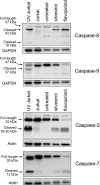The novel plant-derived agent silvestrol has B-cell selective activity in chronic lymphocytic leukemia and acute lymphoblastic leukemia in vitro and in vivo
- PMID: 19190247
- PMCID: PMC2680369
- DOI: 10.1182/blood-2008-09-175430
The novel plant-derived agent silvestrol has B-cell selective activity in chronic lymphocytic leukemia and acute lymphoblastic leukemia in vitro and in vivo
Abstract
Therapeutic options for advanced B-cell acute lymphoblastic leukemia (ALL) and chronic lymphocytic leukemia (CLL) are limited. Available treatments can also deplete T lymphocytes, leaving patients at risk of life-threatening infections. In the National Cancer Institute cell line screen, the structurally unique natural product silvestrol produces an unusual pattern of cytotoxicity that suggests activity in leukemia and selectivity for B cells. We investigated silvestrol efficacy using primary human B-leukemia cells, established B-leukemia cell lines, and animal models. In CLL cells, silvestrol LC(50) (concentration lethal to 50%) is 6.9 nM at 72 hours. At this concentration, there is no difference in sensitivity of cells from patients with or without the del(17p13.1) abnormality. In isolated cells and whole blood, silvestrol is more cytotoxic toward B cells than T cells. Silvestrol causes early reduction in Mcl-1 expression due to translational inhibition with subsequent mitochondrial damage, as evidenced by reactive oxygen species generation and membrane depolarization. In vivo, silvestrol causes significant B-cell reduction in Emu-Tcl-1 transgenic mice and significantly extends survival of 697 xenograft severe combined immunodeficient (SCID) mice without discernible toxicity. These data indicate silvestrol has efficacy against B cells in vitro and in vivo and identify translational inhibition as a potential therapeutic target in B-cell leukemias.
Figures


 ) or 1 μM F-ara A (
) or 1 μM F-ara A ( ). At the indicated times, an aliquot was analyzed by flow cytometry for CD19+ cells (striped bars) and CD3+ cells (solid bars). Data are shown relative to time-matched untreated samples. Bars represent plus or minus SD.
). At the indicated times, an aliquot was analyzed by flow cytometry for CD19+ cells (striped bars) and CD3+ cells (solid bars). Data are shown relative to time-matched untreated samples. Bars represent plus or minus SD.


 . Percentages of cells showing ROS generation (DHE positive) are shown as
. Percentages of cells showing ROS generation (DHE positive) are shown as  and percentages of cells with depolarized mitochondria (monomeric JC-1) are shown as ■. Bars show plus or minus SD. (C) Silvestrol-induced mitochondrial depolarization: CLL patient cells (n = 4) were treated as in panel A, with or without the caspase inhibitor Boc-D-fmk (100 μM). Cells were analyzed at 16 hours by flow cytometry using PI and JC-1. The percentages of cells with intact mitochondria are shown as
and percentages of cells with depolarized mitochondria (monomeric JC-1) are shown as ■. Bars show plus or minus SD. (C) Silvestrol-induced mitochondrial depolarization: CLL patient cells (n = 4) were treated as in panel A, with or without the caspase inhibitor Boc-D-fmk (100 μM). Cells were analyzed at 16 hours by flow cytometry using PI and JC-1. The percentages of cells with intact mitochondria are shown as  , and PI-negative cells are shown as ■. Bars show plus or minus SD. Boc-D-fmk efficacy was confirmed by reversal of annexin-FITC positivity in treated cells (not shown). Although Boc-D-fmk reduced mitochondrial depolarization in silvestrol-treated CLL cells, this effect did not reach statistical significance relative to the untreated sample. (D) Silvestrol causes reduction in mitochondrial Smac/DIABLO: CLL patient cells treated with 80 nM silvestrol or 200 nM flavopiridol for 16 hours were subfractionated and analyzed by immunoblot. Voltage-dependent anion channel (VDAC) was used as a control for mitochondrial fractionation.
, and PI-negative cells are shown as ■. Bars show plus or minus SD. Boc-D-fmk efficacy was confirmed by reversal of annexin-FITC positivity in treated cells (not shown). Although Boc-D-fmk reduced mitochondrial depolarization in silvestrol-treated CLL cells, this effect did not reach statistical significance relative to the untreated sample. (D) Silvestrol causes reduction in mitochondrial Smac/DIABLO: CLL patient cells treated with 80 nM silvestrol or 200 nM flavopiridol for 16 hours were subfractionated and analyzed by immunoblot. Voltage-dependent anion channel (VDAC) was used as a control for mitochondrial fractionation.

References
-
- Wadhwa PD, Morrison VA. Infectious complications of chronic lymphocytic leukemia. Semin Oncol. 2006;33:240–249. - PubMed
-
- Oscier DG, Gardiner AC, Mould SJ, et al. Multivariate analysis of prognostic factors in CLL: clinical stage, IGVH gene mutational status, and loss or mutation of the p53 gene are independent prognostic factors. Blood. 2002;100:1177–1184. - PubMed
-
- Grever MR, Lucas DM, Dewald GW, et al. Comprehensive assessment of genetic and molecular features predicting outcome in patients with chronic lymphocytic leukemia: results from the US Intergroup Phase III Trial E2997. J Clin Oncol. 2007;25:799–804. - PubMed
-
- Bassan R, Gatta G, Tondini C, Willemze R. Adult acute lymphoblastic leukaemia. Crit Rev Oncol Hematol. 2004;50:223–261. - PubMed
-
- Alvarado Y, Apostolidou E, Swords R, Giles FJ. Emerging therapeutic options for Philadelphia-positive acute lymphocytic leukemia. Expert Opin Emerg Drugs. 2007;12:165–179. - PubMed
Publication types
MeSH terms
Substances
Grants and funding
LinkOut - more resources
Full Text Sources
Other Literature Sources

